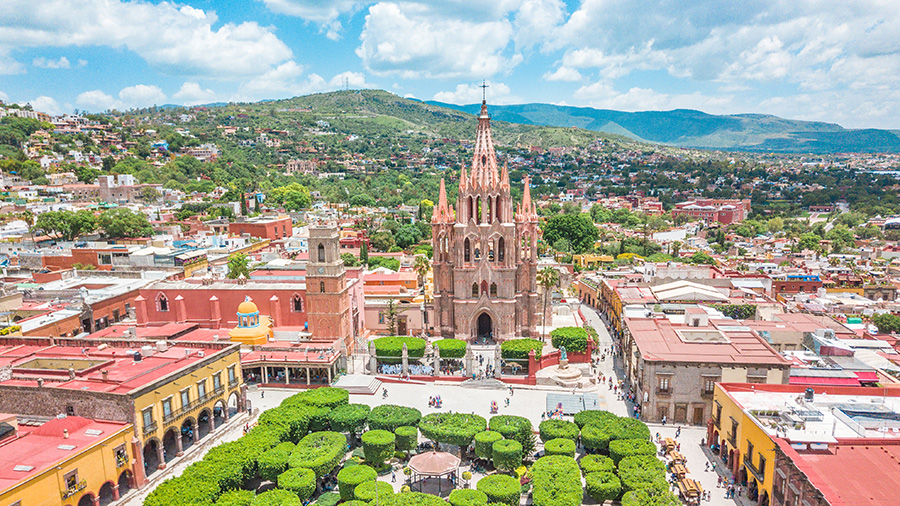
Our skeptical writer avoided San Miguel for years, but finally caved to the raves
Story and photo below by Barry Shlachter
For years, I avoided San Miguel de Allende, Mexico’s photogenic, UNESCO-declared World Heritage City and international art center built on centuries of colonial silver wealth. The more raves I heard, the more I resisted. It seemed to be on almost everyone’s bucket lists but mine. Making me wary was a belief that it had been swamped by entitled American expatriates and mass tourism.
I was wrong. Somehow this Central Highland city has managed to retain authenticity and abundant charm, more so than, say, Santa Fe, New Mexico, where a city employee once told me, “They painted the town brown, and moved the brown people out.”
Every other day, San Miguel seemed to throw a parade or an event, ranging from kindergarteners costumed as butterflies or lions to mark the start of spring, or merchants transforming storefronts into pop-up shrines to various saints and handing out cups of ice cream or soft drinks. None of this was done for the tourists or expats.
One night, on sensory overload after going from one live music spot to another, I heard heart-stirring classical guitar music waft onto the street. Wandering inside, I found performers from Asia, Europe and around Mexico in town for a music festival. They were jamming at a small bar called El Manantial. No cover charge. Simply magical. Toward the end, a wickedly talented Japanese guitarist named Goh Kurosawa started strumming Gianluca Grignani’s “Mi historia entre tus dedos” (“My story through your fingers”), then began singing in Spanish. Wowed, Mexicans in the audience joyfully sang along. He later told me he wasn’t at all surprised by the audience participation. “I was expecting people to join in.”
About 20% of the 175,000 population are foreign residents, roughly half American. I kept hearing San Miguel has engaged them without being tainted. Many run bars, boutique hotels, handicraft businesses or are active in the arts. A former mayor told Smithsonian magazine in 2010 that “this mestizaje — cultural mixing — has profoundly changed and benefited both sides.” Jack LaCalle, a Fort Worth-based documentary filmmaker who attended a church school here as a child, says, “Everybody feels mixed in. It’s so well integrated.”

Pedestrians near San Miguel de Allende’s La Parroquia de San Miguel Arcángel iconic parish church.
“The Americans who come are wealthy but very, very cultured,” said Diana Quintero, the 30-year-old owner of Ki’bok, a popular coffee house with killer avocado toast where former Secretary of Labor Robert Reich and his wife are regulars, and where Bill and Hillary Clinton stopped by for superb espresso drinks in January. The downside is that the influx has driven up rents, forcing Quintero to live on the edge of town.
Few Americans have had as much impact as a Chicagoan named Stirling Dickinson who arrived in 1937 and had a leading role nurturing the San Miguel art scene, LaCalle said. He recruited renowned muralist David Alfaro Siqueiros to teach master classes to World War II vets after arranging acceptance of their GI Bill benefits. Among them was Dotty (née Birk) Vidargas, an ex-Army Air Corps controller who came to study art, married a local businessman and would later be the property agent who sold Fort Worth’s Hyder family a 300-year-old property.
By the 1960s, San Miguel was attracting such beat luminaries as Allen Ginsberg, Jack Kerouac, William Burroughs, Ken Kesey and Neal Cassady, who is said to have returned a dozen times. Cassady inspired a main character in Kerouac’s “On the Road,” and was name checked in Ginsberg’s famous poem, “Howl” — “Praise be to N.C. (Neal Cassady) — the secret hero of my poetry, the studly male god of Denver, Colorado — and the memory of his countless hookups with young women in vacant lots, the yards behind diners, the creaky rows of movie theaters, and mountain caves.” Tragically, Cassady died in a San Miguel rail yard four days before his 42nd birthday after imbibing alcohol and barbiturates.
In some ways, Fort Worthians like restaurateur Brian Sneed and the Hyder family have contributed to the city’s appeal. Sneed founded Quince, an iconic rooftop restaurant here, while the late Martha Hyder restored a dilapidated building into an elegant villa, Casa Hyder, still used by family and friends, and is available for weddings and private events.
Not that there hasn’t been change, said her son, Brent Hyder, whose family first saw San Miguel in 1958. He noted the disappearance of the beloved donkey “train” that transported firewood to town. There is much more traffic and prices are higher, he went on. But it’s a mixed bag. On the town’s outskirts, huge supermarkets and department stores have sprung up, and two scenic golf courses are a short drive away, he said.
LaCalle, whose parents have a home here, said San Miguel attracts a crowd similar to that of Santa Fe, but the allure might be stronger here. “I keep hearing the same explanation from people — they come for two days, then three weeks, then they couldn’t stay away.”
That happened with Ralph Watterson, owner of Fort Worth’s Old Home Supply, who had a two-story brick house built almost completely of recycled and reclaimed materials.
“The quality of life is really hard to match,” said Robin Arena, a Fort Worth resident who has been visiting for 35 years. “It can be a pain to fly to León or Querétaro, then have an hour-long drive. But then you get there, the weight of the world is off your shoulders. It’s safe. It’s open air living in a wonderful climate. When I am in San Miguel I’m a happy person.”
